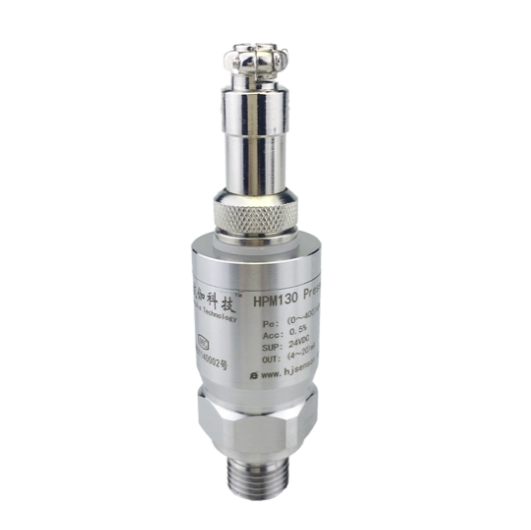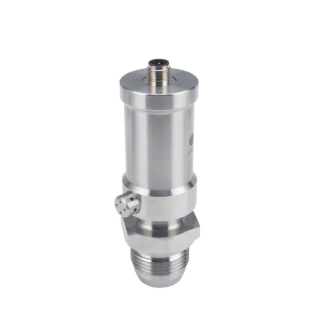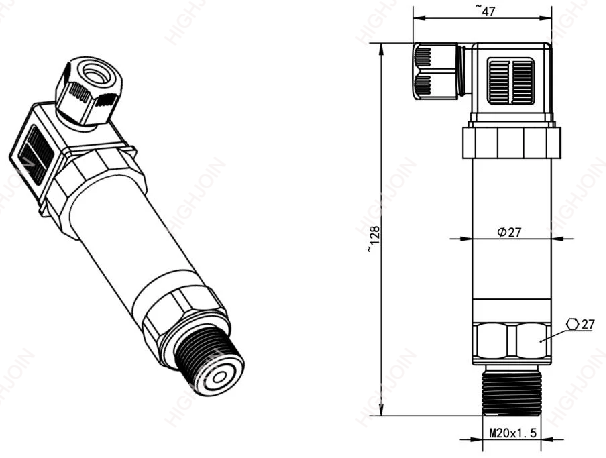What Is A Pressure Measuring Sensor?
Views: 269 Author: Site Editor Publish Time: 2025-03-10 Origin: Site
Introduction
Pressure plays a critical role in countless industries, from manufacturing to healthcare. But how do we measure it accurately? This is where pressure measuring sensors come in. In this post, you'll learn about pressure sensors, their types, and how they help monitor and maintain equipment effectively. We'll also explore how these sensors work to ensure safety and efficiency across industries.

What is a Pressure Measuring Sensor?
A pressure measuring sensor is a device used to detect pressure changes in various environments. It measures the force exerted on an area, which we call pressure. These sensors are vital in both daily life and industrial applications, helping to monitor and maintain the proper functioning of equipment.
Definition
Pressure sensors measure the force applied to a specific area, converting this mechanical pressure into readable data. These sensors are essential for applications like monitoring tire pressure, hydraulic systems, and medical devices such as blood pressure monitors.
In simple terms, they help us understand pressure changes in gases, liquids, and solids by turning them into electrical signals.
Function of Pressure Sensors
Pressure sensors detect pressure changes by measuring physical deformations. For example, a strain gauge sensor might expand or contract when pressure is applied. These physical changes are then converted into electrical signals.
Once converted, these signals are used to monitor equipment. For instance, in hydraulic systems, pressure sensors ensure the system operates within safe limits. In tires, they monitor inflation, preventing over or under-inflation.
Tires: Pressure sensors alert drivers when tire pressure is too low or too high.
Hydraulic systems: They ensure fluid pressure stays within operational limits.
Medical devices: Pressure sensors in devices like blood pressure cuffs measure and monitor the health of individuals.

Key Terms
Understanding pressure sensors requires knowing some key terms.
Pascal (Pa): A unit of pressure that represents one newton per square meter.
psi (Pounds per Square Inch): A common unit for measuring pressure in the U.S.
Bar: Another pressure unit, mostly used in Europe.
It’s important to distinguish between pressure and force. Pressure is the force applied over a specific area, while force is just the total push or pull applied. Pressure, therefore, measures force in relation to the size of the area it affects.
Types of Pressure Measuring Sensors
Pressure sensors come in various types, each designed to meet different needs and applications. Let's explore the most common ones.
1. Strain Gauge Pressure Sensors
Explanation: Strain gauges measure pressure by detecting physical deformation. When pressure is applied, the sensor's material stretches or compresses. This change in shape alters its electrical resistance.
Applications: These sensors are widely used for long-term monitoring in industries like aerospace, automotive, and manufacturing.
Advantages: Strain gauge sensors are cost-effective, versatile, and commonly used in a variety of settings.
2. Piezoelectric Pressure Sensors
Explanation: Piezoelectric sensors convert mechanical stress into an electrical charge. When pressure is applied to the sensor, it generates an electrical signal proportional to the pressure.
Applications: Ideal for small spaces and dynamic pressure measurements, like in sound equipment, vibration testing, and engine pressure monitoring.
Advantages: They have a high-frequency response, making them perfect for measurements that require quick data collection.
3. Capacitive Pressure Sensors
Explanation: Capacitive sensors measure pressure by detecting changes in capacitance. The distance between two conductive plates changes as pressure is applied, altering the capacitance.
Applications: These sensors are used in harsh environments like jet engines and automotive tires, where durability is critical.
Advantages: Their simple mechanical design makes them robust and reliable in extreme conditions.
4. Manometers
Explanation: Manometers are traditional devices that use liquid-filled tubes to measure pressure. The liquid inside moves when pressure is applied, and the displacement is used to calculate the pressure difference.
Applications: Commonly used in laboratories or simple systems where precise measurements aren’t necessary.
Limitations: Manometers are slower in response and have a limited range of pressures they can measure accurately.
5. Vacuum Pressure Sensors
Explanation: These sensors measure pressure in vacuum environments. Instead of relying on mechanical movements, they observe how pressure affects the properties of materials, such as the resistance in a heated filament.
Applications: Used in advanced technologies, like semiconductor manufacturing and research laboratories.
Specific Sensors: The Pirani sensor, for instance, measures pressure by detecting changes in the filament's temperature due to vacuum conditions.
6. Bourdon Tube Pressure Sensors
Explanation: The Bourdon tube uses a coiled tube that straightens when pressure is applied. This movement is mechanically linked to a dial that shows the pressure reading.
Applications: Typically used in high-pressure applications like industrial machinery and steam systems.
Advantages: Simple, durable, and cost-effective, though it can be sensitive to shock and vibration.
7. Aneroid Barometers
Explanation: Aneroid barometers measure atmospheric pressure using a sealed, flexible metal chamber. Changes in pressure cause the chamber to expand or contract, moving a needle to indicate pressure levels.
Applications: Often found in weather stations, aircraft, and portable barometers.
Advantages: They are compact, durable, and do not require liquid, making them ideal for portable use in various environments.

How Do Pressure Measuring Sensors Work?
Pressure measuring sensors work by detecting and responding to pressure changes, converting them into electrical signals for easy interpretation. Let’s break down how this process works.
The Sensing Mechanism
Physical Changes: When pressure is applied to a sensor, it causes a physical change in the sensor's structure. This could be a strain or displacement, like a metal diaphragm bending or a material stretching. These changes are proportional to the amount of pressure applied.
Signal Conversion: Once the sensor detects these physical changes, it converts them into electrical signals. For example, a strain gauge sensor measures the deformation and translates it into a measurable change in electrical resistance. The sensor then converts these changes into a readable signal that can be interpreted by monitoring systems.
4-20 mA: This is the most common analog signal used in industrial applications. It represents a pressure range, where 4 mA indicates the lowest pressure and 20 mA the highest.
0-5 V: This signal is used for systems that require a simple, low-voltage range to indicate pressure.
Types of Signals: Pressure sensors typically send out signals such as 4-20 mA or 0-5 V.
Calibration of Pressure Sensors
Why Calibration is Important: Calibration ensures the pressure sensor provides accurate readings. It’s essential for reliability and safety in any system that depends on precise pressure measurements.
Common Calibration Methods: The two main methods for calibrating pressure sensors are:
Zero Calibration: This method sets the sensor’s baseline, ensuring that it reads zero when no pressure is applied.
Span Calibration: This adjusts the sensor’s output across its entire range. It ensures the sensor accurately measures pressure from its minimum to maximum values.
Key Benefits of Pressure Measuring Sensors
Pressure measuring sensors offer significant benefits in various industries, especially when it comes to improving maintenance, safety, and cost efficiency.
Improved Predictive Maintenance
Early Detection of Issues: Pressure sensors help maintenance teams detect issues early. By monitoring pressure levels in real-time, the sensors can identify any abnormal changes, signaling potential problems before they become critical.
Examples: For instance, sensors can detect when a hydraulic system's pressure falls outside the normal range, allowing for timely intervention to prevent equipment failure.
Increased Safety and Reliability
Risk Mitigation: Pressure sensors are crucial in preventing catastrophic failures in pressurized systems. By continuously monitoring pressure levels, these sensors help avoid accidents caused by overpressure or pressure loss.
Safety Protocols: Sensors ensure equipment operates within safe limits, alerting maintenance teams when action is needed to avoid damage or risk to personnel.
Cost Savings
Reducing Downtime: Early detection of pressure-related issues helps reduce downtime. Sensors identify problems before they cause major disruptions, allowing for quick fixes and minimizing operational halts.
Long-Term Investment: Investing in pressure sensors and predictive maintenance saves money in the long run. By preventing expensive repairs and equipment replacements, businesses can keep their operations running smoothly at lower costs.
Popular Applications of Pressure Measuring Sensors
Pressure measuring sensors are used in various industries to ensure the smooth functioning of equipment, enhance safety, and improve operational efficiency. Here are some common applications:
Industrial and Manufacturing Applications
Hydraulic and Pneumatic Systems: Pressure sensors are essential for monitoring fluid pressures in hydraulic and pneumatic systems. By keeping track of pressure levels, these sensors help prevent system failures that could disrupt operations.
Steam Systems: In industries where steam is used, pressure sensors regulate and control steam pressure. They ensure the pressure stays within safe limits, preventing accidents and optimizing system performance.
Filter Monitoring: Sensors are also installed in filters to detect blockages. As the pressure before and after a filter changes, sensors alert operators when maintenance is required, reducing downtime.
Automotive Applications
Tire Pressure Monitoring: Modern vehicles use pressure sensors to monitor tire pressure. These sensors provide real-time data to the driver, ensuring the tires are neither under-inflated nor over-inflated, improving safety and fuel efficiency.
Engine Pressure: Sensors also monitor engine systems, checking oil and coolant pressures. This ensures that the engine operates within optimal conditions, preventing damage and ensuring long-term reliability.
Environmental and Energy Applications
Environmental Monitoring: Pressure sensors are used to track atmospheric pressure, helping with weather forecasting and pollution detection. They also monitor pressure changes in ecosystems, which is crucial for environmental protection.
Energy Conservation: In energy management systems, pressure sensors optimize energy usage. By monitoring pressure in heating, cooling, and fluid systems, sensors help reduce energy consumption, contributing to overall cost savings.
Medical and Health Applications
Medical Equipment: Pressure sensors are commonly found in medical devices like blood pressure cuffs, respirators, and dialysis machines. These sensors monitor and regulate pressure in critical healthcare applications.
Health Monitoring: In patient monitoring systems, pressure sensors measure blood pressure, airflow, and other vital parameters, ensuring patients receive accurate and timely care.
Understanding Pressure Measurements: Key Terms
Pressure sensors measure different types of pressure, each with unique applications and purposes. Here are some key terms you should know:
Gauge Pressure
Explanation: Gauge pressure measures the pressure relative to the atmospheric pressure. Essentially, it shows the pressure difference from the surrounding air pressure.
Applications: This type of pressure measurement is common in everyday sensors, such as in car tires and household appliances, where pressure changes are measured relative to the atmosphere.
Absolute Pressure
Explanation: Absolute pressure measures the total pressure exerted, including the atmospheric pressure. It is referenced from a perfect vacuum, where no pressure exists.
Applications: This is used in more sensitive scientific applications like weather stations, research labs, and aerospace systems, where precise measurements are critical.
Differential Pressure
Explanation: Differential pressure measures the difference between two pressure points. It compares the pressure at one location to another.
Applications: This type of measurement is used in tanks to measure liquid levels or to monitor pressure changes across filters in industrial systems, helping detect clogs and system performance issues.
How to Choose the Right Pressure Measuring Sensor
Choosing the right pressure measuring sensor is essential for accurate measurements and efficient operations. Here’s what you should consider:
Factors to Consider
Sensitivity: How responsive the sensor is to pressure changes. More sensitive sensors are ideal for applications where even small changes in pressure are important.
Accuracy: Ensure the sensor provides reliable and precise readings. High accuracy is crucial for critical systems where pressure deviations could cause failures.
Range: The pressure range the sensor can measure. You need to select a sensor that covers the expected pressure levels in your system.
Environment: Consider environmental factors like temperature, humidity, and exposure to corrosive substances. Choose a sensor designed to withstand the specific conditions in which it will operate.
Common Considerations
Type of Pressure: Determine whether you need to measure gauge, absolute, or differential pressure. The type of pressure measurement impacts sensor selection.
Environment: Take into account temperature extremes, exposure to chemicals, or high vibration. Some sensors are more suited for harsh environments than others.
Maintenance Needs: Sensors in remote or hard-to-access locations might require low-maintenance options. Consider ease of calibration and the lifespan of the sensor in your decision.
Conclusion
Pressure measuring sensors are crucial in many industries, ensuring accurate measurements and efficient operations. These sensors help monitor, control, and maintain pressure in various systems. They are indispensable for industries that rely on precision and safety. Explore pressure sensor options today to enhance predictive maintenance and optimize your operations.
Q: What is the difference between a pressure sensor and a pressure transducer?
A: A pressure sensor detects and measures pressure, while a pressure transducer converts the pressure measurement into an electrical signal for further analysis.
Q: Can pressure sensors be used in extreme temperatures?
A: Yes, many pressure sensors are designed to withstand extreme temperatures. However, it's important to choose sensors rated for the specific temperature range of your application.
Q: How long do pressure sensors typically last?
A: Pressure sensors typically last several years, depending on their design, usage, and maintenance. Regular calibration and care can extend their lifespan.
Q: What industries benefit most from pressure sensors?
A: Industries such as manufacturing, automotive, healthcare, energy, and environmental monitoring benefit greatly from pressure sensors for safety, efficiency, and system reliability.
